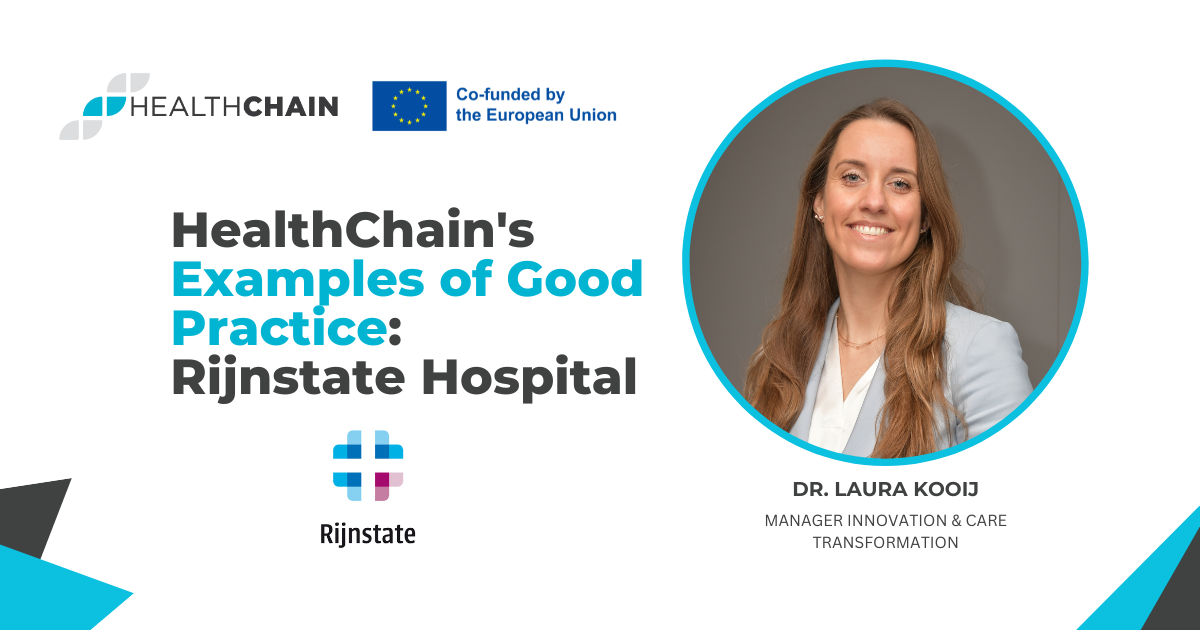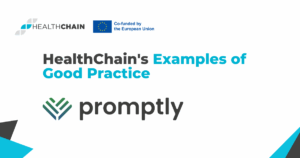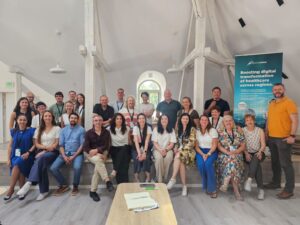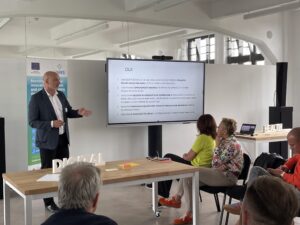Welcome to ‘HealthChain’s Examples of Good Practice,’ a series within the HealthChain project that highlights successful and innovative companies, hospitals, solutions, business models, and approaches in the healthcare sector.
In this edition, we’re featuring Rijnstate Hospital, an innovative hospital located in Arnhem, Netherlands. We spoke with Dr. Laura Kooij, Manager Innovation & Care Transformation at Rijnstate Hospital.
Tell us more about the Rijnstate Hospital.
Rijnstate is a large teaching hospital in the Netherlands with three locations in Arnhem (for high complex, intensive and emergency care), Zevenaar (planned care) and Elst (out-patient hospital for research and treatment). We have over 433.000 citizens in our service area, 702 beds and 29 specialties with a high patient rating (on average 8.6 out of 10). (*Rijnstate Annual report 2023, jaarverslag.rijnstate.nl). We aim to be at the forefront of clinical care, and we invest in innovations, AI solutions and robotics.
What were the primary drivers that initially prompted Rijnstate to invest in digital solutions for patient care?
Healthcare is facing multiple challenges including the aging population, labor shortage and rising healthcare costs. Digital healthcare transformation is necessary to deliver accessible, high quality and affordable care now and in the future. Digital technologies are promising in supporting the ongoing transformation of care, assisting healthcare professionals and ensuring accessible care for patients.
Rijnstate has a strong reputation for innovation. Could you describe the process Rijnstate follows from identifying a need for a digital solution to its eventual implementation and evaluation?
Rijnstate has a strong focus on innovation, so therefore innovation is part of our multi-year strategy. We have an Innovation & Care Transformation department with the aim to stimulate, develop, implement, accelerate and realize innovation and new care concepts for our patients and citizens of our region. We also have a Robotics department, with specific expertise in the use and implementation of (innovative) robotics solutions in the hospital care setting, to ensure true value for the patient and the care professionals. Every innovation project starts with a need, problem or wish. For example, we want to reduce hospital length of stay, reduce workload and/or deliver more appropriate care. Together with healthcare professionals and other stakeholders we define the goals and what is needed to achieve these goals.
In the case of remote patient monitoring, the goals are to reduce hospital visits, reduce length of stay, improve patient self-management, satisfaction and/or other patient outcomes. After defining the goal, we select the right solution – for example a technology – and start the implementation. This requires oftentimes a redesign of a current care process or a design of a new care process. We also focus on changes in work processes for healthcare professionals, technology integration and financial aspects.
Could you elaborate on the specific digital solutions currently in use at Rijnstate (e.g., Virtual Care Center and Monitoring@home)? What are their core functionalities and intended benefits?
In Rijnstate we focus on innovation such as labor-saving technologies to support healthcare professionals, for example to reduce administrative tasks by making use of smart systems. Other examples are the use of artificial intelligence to assist our healthcare professionals minimizing their registration tasks, supporting in the diagnostics process and in (pre)clinical planning. Robotics is leveraged to add precision and quality insights while reducing physical strain during surgery, nursing, logistics as well as the pharmacological process. Digital solutions are also implemented to support patients, ensure accessibility of care, for communication purposes and to deliver (more) personalized care. The patient portal (‘Mijn Rijnstate’) for example gives patients access to information from their medical records, appointments and video consultations. Patients can also complete questionnaires.
In Rijnstate we aim to deliver care at home if possible and in the hospital if necessary. One of the solutions is remote patient monitoring. With monitoring of vital signs in combination with questionnaires, healthcare professionals can monitor patients in the home setting. We also provide patient education, for example on improving self-management. In 2021 we started the Virtual Care Center, a hospital department staffed by registered nurses responsible for remote patient monitoring. The nurses have contact with the patients and healthcare professionals inside and outside the hospital. Remote patient monitoring consists of vital signs and outcomes of questionnaires. The Virtual Care Center nurses receive notifications in case of deviating values. We provide remote patient monitoring for ‘clinical patients’ and ‘outpatients’. The aim of clinical patient monitoring processes is reducing length of stay and improving (or maintaining high) patient satisfaction. The aim of outpatient remote patient monitoring is reducing hospital visits, consultations, improving self-management and improving (or maintaining high) patient satisfaction and other patient outcomes.
The development of a new remote patient care process always starts by defining the goals. Then we select the right technology and monitoring solutions such as a mobile application and heart rate or blood pressure monitor. Also, a (medical) protocol is developed with inclusion criteria, agreements and responsibilities. We (re)design care processes or design new care processes, for successful uptake and use, with integration of the technologies. This way patients can go home earlier to recover and only come to the hospital if necessary.
What were the biggest challenges encountered during the implementation of these digital solutions, and how were they overcome?
Challenges of implementation of innovation or digital solutions can occur at different levels and taking these factors into account can result in successful implementation. For example:
- Healthcare professionals – For acceptability of a new digital solution or change in work process, it is essential to include stakeholders during the process. We address this challenge by engaging healthcare professionals at an early stage, especially the front-runners, throughout the whole development, implementation and evaluation phase. We employ an iterative, short-cyclic, learning-oriented approach to quickly assess new information or outcomes, to enable true transformation of the process and leverage of the new digital solution.
- Patients – Patients must be engaged throughout the (implementation) process, whenever digital solutions impact them or their care. For example, taking digital health literacy into account during development and implementation is important.
- Organization – Prioritizing and investing in innovation and digital solutions are important factors for success.
- Process – Successful implementation of digital solutions and innovation requires a redesign of a current care process or development of a new care process, together with all stakeholders. This also includes the process for the (healthcare) professionals.
- Technology – The design and setup of the technology, for example decision making on standalone implementation or integrated with existing systems (such as the Electronic Medical Record)
- Finance – Investment and reimbursement can be a challenge or can stimulate innovation.
It is important to take these factors into account during implementation to achieve successful implementation.
What are Rijnstate’s future plans and vision for digital healthcare in the coming years? What emerging technologies are you exploring?
In the coming year we continue to strive to add value to and support our healthcare professionals and patients and to maintain high-quality, accessible and affordable care, now and in the future. This includes further implementation and uptake of healthcare improving and labor-saving technologies – such as AI solutions and smart (monitoring) systems – while ensuring proper integration in care and work processes.
You are participating in several EU co-funded projects. How important is that for the Hospital and the development of digital solutions?
The participation in EU co-funded projects provides us with the opportunities to develop new innovations in co-creation with different (healthcare and technology) organizations. An additional benefit is also to be able to exchange knowledge with (healthcare) organizations in other EU countries.
In the name of the HealthChain project, we would like to thank Dr. Laura Kooij and the entire team at Rijnstate Hospital for sharing their valuable insights.
Disclaimer: HealthChain project is funded by the European Union. Views and opinions expressed are, however, those of the author(s) only and do not necessarily reflect those of the European Union or European Innovation Council and SMEs Executive Agency (EISMEA). Neither the European Union nor the granting authority can be held responsible for them.








